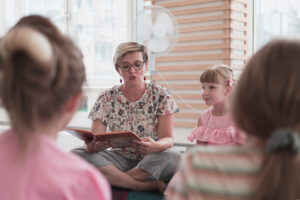Introduction to language learning in childcare centres
As our world becomes increasingly interconnected and diverse, the importance of teaching new languages to children cannot be overstated.
In recent years, there has been a growing interest in incorporating new language teaching for kids in childcare centres.
This trend is not only beneficial for the children involved, but it also has the potential to create a more culturally rich and inclusive society.
In this article, I will explore the myriad benefits of teaching a new language to young minds in childcare centres, as well as delve into the various teaching methods available for this age group.
I will also share success stories and provide resources for those interested in implementing language programs in their own childcare centres.
By the end of this article, you will undoubtedly see the power and potential that teaching a new language has in shaping the minds of our youngest generation.
As we embark on this journey to unlock the endless possibilities of language learning, let us first examine the importance of early language exposure and the cognitive advantages it brings.
The importance of early language exposure
Research has shown that the earlier a child is exposed to a new language, the better their chances are of becoming proficient in that language.
This is because the brain is at its most flexible and adaptable during the early years of life, making it the ideal time for language learning.
In fact, some studies suggest that children who are exposed to a second language before the age of five have a higher likelihood of speaking that language with native-like fluency.
Moreover, early language exposure has been linked to a host of other cognitive benefits. For instance, bilingual children have been found to perform better on tasks that require attention, problem-solving, and multitasking.
This is because learning a new language exercises the brain’s executive functions, which are responsible for these higher-order cognitive skills.
The benefits of early language exposure extend beyond cognitive advantages, however. Let us now delve into the social and emotional benefits of bilingualism in young children.
Cognitive benefits of learning a new language
Children who learn a new language at an early age often experience a range of cognitive benefits that can last a lifetime.
For example, bilingualism has been shown to improve memory, creativity, and critical thinking skills.
Furthermore, learning a new language also helps to strengthen the brain’s neural networks, making it more efficient at processing information and adapting to new situations.
Moreover, learning a new language has been linked to increased cognitive flexibility, as children who speak multiple languages are better able to switch between different tasks and ways of thinking.
This ability can be especially beneficial in our rapidly changing world, where adaptability is a highly prized skill.
Finally, research has also shown that learning a new language can help protect the brain against cognitive decline in later life.
In fact, bilingualism has been associated with a reduced risk of developing dementia and Alzheimer’s disease.
Clearly, the cognitive benefits of learning a new language are both vast and long-lasting, making it an invaluable investment for young minds.
Social and emotional benefits of bilingualism
In addition to the cognitive advantages, teaching a new language to young children also has numerous social and emotional benefits.
For one, bilingualism can help to foster a sense of identity and belonging, as children who speak more than one language often have a deeper connection to their cultural heritage.
This can be particularly valuable for children from immigrant families, who may struggle to reconcile their dual identities.
Furthermore, speaking multiple languages can help to improve children’s social skills and empathy, as they are better able to communicate with and understand the perspectives of others.
Bilingual children are also more likely to display tolerance and open-mindedness towards people from different cultural backgrounds, which can contribute to the creation of a more inclusive society.
Lastly, learning a new language can help to boost children’s self-esteem and confidence, as it provides them with a unique and valuable skill.
This sense of accomplishment can then translate to other areas of their lives, as they develop the resilience and determination needed to tackle new challenges.
Enhancing cultural awareness and appreciation
Teaching a new language to young children not only equips them with valuable linguistic skills, but also helps to foster an appreciation for other cultures.
In today’s globalized world, it is more important than ever for individuals to have a broad understanding of different cultures and perspectives.
By learning a new language, children are exposed to the customs, traditions, and values of other societies, helping to broaden their horizons and promote cultural awareness.
Furthermore, fostering cultural appreciation from an early age can help to counteract negative stereotypes and prejudices that may exist in society.
By exposing children to different languages and cultures, we can help to create a more open-minded and accepting generation, who are better equipped to navigate our increasingly diverse and interconnected world.
Language teaching methods for young children
When it comes to teaching new languages to young children, there are a variety of methods and techniques that can be employed. Some of the most popular methods include:
Immersion: This approach involves immersing children in the target language by surrounding them with native speakers and providing opportunities for them to engage in authentic conversations. This can be achieved by hiring bilingual staff or inviting native-speaking volunteers to the childcare centre.
Play-based learning: Young children learn best through play, and language learning is no exception. Incorporating games, songs, and stories in the target language can make the learning process fun and engaging, helping children to acquire new vocabulary and linguistic structures more easily.
Visual aids: Using visual aids such as flashcards, posters, and videos can help to reinforce new vocabulary and concepts, making it easier for children to remember and understand them.
Technology: There are numerous language learning apps and software available that are specifically designed for young children. These tools can be a valuable supplement to traditional teaching methods, as they often offer interactive and engaging activities that can help to reinforce new language skills.
Incorporating new language teaching in childcare centres
To successfully incorporate new language teaching for kids in childcare centres, it is important to create a supportive and engaging learning environment. This can be achieved by:
- Providing access to a range of language learning resources, such as books, games, and multimedia content.
- Encouraging collaboration and group work, as this can help to foster a sense of community and promote language learning through peer interaction.
- Offering regular opportunities for children to practice and use their new language skills in real-life situations, such as role-playing, storytelling, or even field trips to cultural events.
It is also crucial to involve parents and caregivers in the language learning process, as their support and encouragement can have a significant impact on children’s motivation and success.
This can be done by providing regular updates on children’s progress, offering tips and resources for language learning at home, and organizing family events that celebrate the target language and culture.
Success stories: how teaching a new language has impacted young minds
There are countless success stories of young children who have benefited from learning a new language in childcare centres.
Many of these children have gone on to develop an enduring passion for languages and cultures, often leading to increased academic success and a more enriched life experience.
For example, a childcare centre in Australia introduced a Mandarin Chinese program for their students, which not only led to improved language skills but also promoted cross-cultural understanding and friendship between the children.
Similarly, a bilingual preschool in the United States has seen its students develop a strong sense of cultural identity and pride in their linguistic abilities, leading to increased self-confidence and agreater appreciation for the diversity of the world around them.
There are also numerous personal success stories of children who have gained valuable skills and experiences through language learning.
For instance, a young girl named Julia was able to connect with her Japanese heritage through learning the language, which allowed her to communicate with her grandmother and learn more about her family’s history.
Another child, named Diego, was able to use his Spanish language skills to communicate with his grandparents and understand the cultural traditions of his family.
These success stories demonstrate the power and potential of language learning in shaping the minds of our youngest generation. By unlocking the endless possibilities of language learning, we can help to create a more inclusive and culturally rich society.
Resources for implementing language programs in childcare centres
For those interested in implementing language programs in their own childcare centres, there are numerous resources available to support this endeavor. Some of these resources include:
Language learning software and apps: There are numerous language learning apps and software available that are specifically designed for young children. These tools can be a valuable supplement to traditional teaching methods, as they often offer interactive and engaging activities that can help to reinforce new language skills.
Professional development resources: There are a variety of professional development resources available for childcare centre staff who are interested in learning more about language teaching methods and techniques. These resources can include workshops, webinars, and online courses.
Community resources: Many communities have language programs or language exchange groups that can be a valuable resource for childcare centres looking to incorporate new language teaching. These programs can offer access to native speakers and cultural events, as well as provide opportunities for children to practice their language skills in real-life situations.
Collaboration with other childcare centres: Working with other childcare centres that offer language programs can be a valuable resource for sharing best practices and resources, as well as for creating a network of support.
Conclusion: unlocking the potential of young minds through language learning
In conclusion, teaching a new language to young minds in childcare centres has the potential to unlock endless possibilities, both for the children involved and for society as a whole.
From the cognitive benefits of early language exposure to the social and emotional advantages of bilingualism, there are countless reasons to invest in language learning for our youngest generation.
Furthermore, by promoting cultural awareness and fostering an appreciation for diversity, language learning can help to create a more inclusive and accepting society.
As we continue to navigate an increasingly globalized world, the ability to communicate in multiple languages has become an invaluable skill, one that can open doors and create opportunities for personal and professional growth.
By incorporating new language teaching in childcare centres, we can help to unlock the potential of young minds and create a more vibrant and diverse community.
So let us embrace the power of language learning and unlock the endless possibilities it has to offer.
If you are interested in implementing a new language program in your childcare centre or learning more about language teaching methods for young children, be sure to check out the resources available in your community and online.
Together, we can unlock the potential of young minds and create a more inclusive and culturally rich society.












